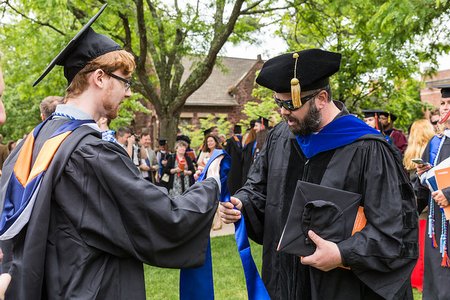The Presidential Medallion
The Gettysburg College presidential medallion and chain was created in 1978 for the inauguration of Charles E. Glassick, the eleventh president, by Norman L. Annis, former professor of art. The medallion features the former College seal, three inches in diameter. The seal is flanked by two smaller medallions, one being the seal of the Evangelical Lutheran Church in America and the other depicting symbols of higher education. The one-inch medallions, which constitute the chain, list the past presidents and the dates they served the College.
The Beachem Portico
The portico on the north side of Pennsylvania Hall is properly known as the Beachem Portico, erected with funds given by the Alumni Association and dedicated to the memory of the College’s first alumni secretary, Charles W. Beachem. Gettysburg College’s Alumni Association is among the oldest in the nation and particularly notable for having been formed within three years of the 1832 founding of the College. The Alumni Association of Pennsylvania College (as it was then known) was founded on commencement day, September 16, 1835. There were eleven initial members, the graduates of 1834 and 1835.
Stole of Gratitude
 The “stole of gratitude,” a tradition which began in 2004, is in part a gift from the Gettysburg College Alumni Association. The graduates will wear the stoles throughout the Commencement Exercises as a symbol of their appreciation for all of the individuals whose support was instrumental in bringing them to this day. At the reception following Commencement, graduates may present the stole to someone to demonstrate their gratitude for that individual’s role in their success.
The “stole of gratitude,” a tradition which began in 2004, is in part a gift from the Gettysburg College Alumni Association. The graduates will wear the stoles throughout the Commencement Exercises as a symbol of their appreciation for all of the individuals whose support was instrumental in bringing them to this day. At the reception following Commencement, graduates may present the stole to someone to demonstrate their gratitude for that individual’s role in their success.
President’s Chair
The President’s Chair comes from the estate of Dr. F. William Sunderman Sr., a 1919 graduate of Gettysburg College. In 1983 he created the Sunderman Foundation for Chamber Music, which presents a concert series on campus each year. He was also a trustee emeritus of the College and the founder of its annual Henry M. Scharf Lecture on Current Affairs. Upon Dr. Sunderman’s death in 2003, his legacy provided for the establishment of the College’s F. William Sunderman Sr. Conservatory of Music, which began admitting students in the fall of 2006.
Academic Regalia
Academic ceremonies, with their gowns, mortarboards, tassels, hoods, and maces are colorful traditions handed down from European universities of the Middle Ages. The first organized institutions of learning took form during the twelfth and thirteenth centuries, generally under the jurisdiction of the church. Academic regalia, as we know it today, have evolved from the robes, hoods, and caps worn mainly for warmth in unheated buildings by the clerics, monks, and priests who were the first students. While European universities continue to show great diversity in their academic dress, American universities, in 1895, adopted a code of academic uniformity.